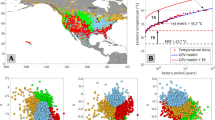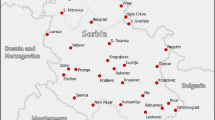Abstract
The features of changes and variability for cold temperature extremes over Russia are analyzed using observational data for the period from the middle of the 20th century. The impact is assessed that observed changes in thermal regime make on the characteristics of rare extremes which are used as standard parameters for designing infrastructure facilities. The results are interpreted in terms of the power system operation reliability. The risk assessment for critical temperature impacts indicates the important regional features of climate change effect on extreme energy loads and requirements for power capacities during the cold season.
Similar content being viewed by others
References
M. Yu. Bardin, O. N. Bulygina, and T. V. Platova, “Extremeness of Climate,” in SecondRoshydrometAssessment Report on Climate Change and Its Consequences in Russian Federation (Roshydromet, Moscow, 2014) [in Russian].
M. Yu. Bardin, T. V. Platova, and O. F. Samokhina, “Climate Change Features in Northern Eurasia Based on the Routine Climate Monitoring and Their Possible Factors,” Trudy Gidromettsentra Rossii, No. 358 (2015) [in Russian].
Second Roshydromet Assessment Report on Climate Change andIts Consequences in Russian Federation, Ed. by V. M. Kattsov and S. M. Semenov (Roshydromet, Moscow, 2014) [in Russian].
Report on Climate Features in the Russian Federation in 2015 (Roshydromet, Moscow, 2016) [in Russian].
V. M. Kattsov, I. M. Shkolnik, S. V. Efimov, A. V. Konstantinov, V. N. Pavlova, T. V. Pavlova, E. I. Khlebnikova, A. A. Pikaleva, A. V. Baidin, and V. A. Borisenko, “Development ofthe Technology for Probability Forecasting of Regional Climate in Russia and Construction of Scenario Forecasts of Climate Change Impacts on Economic Sectors. Part 1: Problem Statement and Numerical Experiments,” Trudy GGO, No. 583 (2016) [in Russian].
A. V. Kislov and T. A. Matveeva, “Extreme Wind Speeds in the European Sector of the Arctic,” Meteorol. Gidrol., No. 7 (2016) [Russ. Meteorol. Hydrol., No. 7, 41 (2016)].
M. R. Leadbetter, G. Lindgren, and H. Rootzen, Extremes and Related Properties of Random Sequences and Processes (Mir, Moscow, 1989) [Transl. from Engl.].
E. I. Khlebnikova and T. A. Datsyuk, “Construction, Land Transport, Fuel and Energy Sector,” in Second Roshydromet Ass essment Report on the Climate Change and Its Consequences in the Russ ian Federa tion (Roshydromet, Moscow, 2014) [in Russian].
E. I. Khlebnikova, I. A. Sall', and I. M. Shkolnik, “Regional Climate Changes as the Factors of Impact on the Objects of Construction and Infrastructure,” Meteorol. Gidrol., No. 12 (2012) [Russ. Meteorol. Hydrol., No. 11–12, 37 (2012)].
L. V. Alexander, “Global Observed Long–term Changes in Temperature and Precipitation Extremes: A Review of Progress and Limitations in IPCC Assessments and Beyond,” Weather and Climate Extremes, 11 (2016).
D. R. Easterling, K. E. Kunkel, M. F. Wehner, and L. Sun, “Detection and Attribution of Climate Extremes in the Observed Record,” Weather and Climate Extremes, 11 (2016).
A. R. Ganguly, K. Steinhaeusera, D. J. Erickson, M. Branstetter, E. S. Parish, N. Singh, J. B. Drake, and L. Buja, “Higher Trends but Larger Uncertainty and Geographic Variability in 21st Century Temperature and Heat Waves,” Proc. Nat. Acad. Sci. USA, No. 15, 106 (2009).
R. W. Katz, “Statistics of Extremes in Climate Change,” Climatic Change, 100 (2010).
V. V. Kharin, F. W. Zwiers, X. Zhang, and M. Wehner, “Changes in Temperature and Precipitation Extremes in the CMIP5 Ensemble,” Climatic Change, No. 2, 119 (2013).
D. Kiktev, D. M. H. Sexton, L. Alexander, and C. K. Folland, “Comparison of Modeled and Observed Trends in Indices of Daily Climate Extremes,” J. Climate, 16 (2003).
E. Kodra, K. Steinhaeuser, and A. R. Ganguly, “Persisting Cold Extremes under 21st Century Warming Scenarios,” Geophys. Res. Lett., 38 (2011).
Managing the Risks of Extreme Events and Disasters to Advance Climate Change Adaptation. A Special Report of Working Groups I and II of the Intergovernmental Panel on Climate Change, Ed. by C. B. Field, V. Barros, T. F. Stocker, D. Qin, D. J. Dokken, K. L. Ebi, M. D. Mastrandrea, K. J. Mach, G.–K. Plattner, S. K. Allen, M. Tignor, and P. M. Midgley (Cambridge Univ. Press, Cambridge, UK and New York, NY, USA, 2012).
G. Meehl and C. Tebaldi, “More Int ense, More Frequent, and Longer Lasting Heat Waves in the Twenty–first Century,” Science, 305 (2004).
S. Parey, T. T. H. Hoang, and D. Dacunha–Castelle, “Different Ways to Compute Temperature Return Levels in the Climate Change Context,” Environmetrics, 21 (2010).
H. Rootzen and R. W. Katz, “Design Life Level: Quantifying Risk in a Changing Climate,” Water Resour. Res., 49 (2013).
H. Storch and F. W. Zwiers, Statistical Analysis in Climate Research (Cambridge Univ. Press, 2002).
World Meteorological Organization. Guidelines on Analysis of Extremes in a Changing Climate in Support of Informed Decisions for Adaptation (WCDMP–72) (Geneva, 2009).
World Meteorological Organization. Guide to Climatological Practices (WMO–No. 100) (Geneva, 2011).
X. Zhang, L. V. Alexander, G. C. Hegerl, P. D. Jones, A. K. Tank, T. C. Peterson, B. Trewin, and F. W. Zwiers, “Indices for Monitoring Changes in Extremes Based on Daily Temperature and Precipitation Data,” Wiley Interdisciplinary Review: Climatic Change, 2 (2011).
X. Zhang, J. Wang, F. W. Zwiers, and P. Y. Groisman, “The Influence of Large–scale Climate Variability on Winter Maximum Daily Precipitation over North America,” J. Climate, 23 (2010).
F. W. Zwiers, L. V. Alexander, G. C. Hegerl, T. R. Knutson, J. P. Kossin, P. Naveau, N. Nicholls, C. Schor, S. I. Seneviratne, and X. Zhang, “Climate Extremes: Challenges in Estimating and Understanding Recent Changes in the Frequency and Intensity of Extreme Climate and Weather Events,” in CUmate Science for Seeing Society: Research, Modelling and Prediction Priorities, Ed. by G. R. Asrar and J. W. Hurrell (Springer, Geneva, 2013).
F. W. Zwiers, X. Zhang, and J. Feng, “Anthropogenic Influence on Long Return Period Daily Temperature Extremes at Regional Scales,” J. Climate, 24 (2011).
Author information
Authors and Affiliations
Corresponding author
Additional information
Original Russian Text © E.I. Khlebnikova, I.A. Sail', 2018, published in Meteorologiya i Gidrologiya, 2018, No. 6, pp. 41–51.
About this article
Cite this article
Khlebnikova, E.I., Sall’, I.A. Cold Temperature Extremes in Russia and Risks of Critical Temperature Impacts on Infrastructure Facilities. Russ. Meteorol. Hydrol. 43, 372–378 (2018). https://doi.org/10.3103/S1068373918060043
Received:
Accepted:
Published:
Issue Date:
DOI: https://doi.org/10.3103/S1068373918060043




